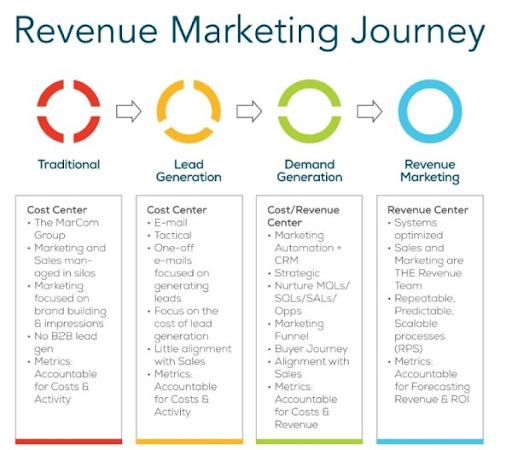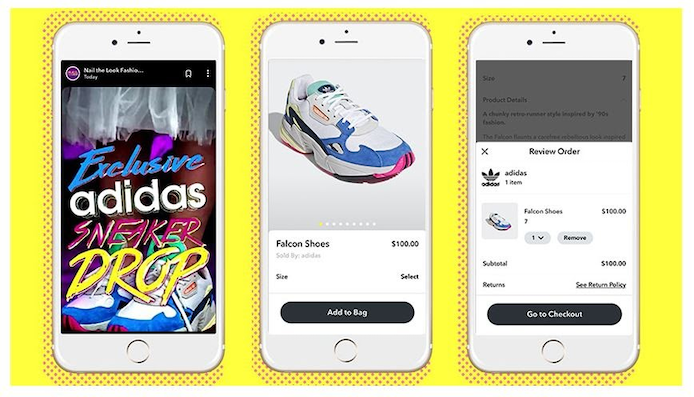Choosing the best approach to your company’s marketing is never easy. Even with all of the methods you have available to you, it can be all too easy to focus on the wrong elements of your marketing when you are new to this area and overlook important business metrics, like revenue.

Your marketing work should always be done with the aim that you will be able to increase your revenue. While this may sound obvious, it can be quite challenging to connect the time, effort, and money you spend on your marketing with the revenue you earn at the end of each month.
Thankfully, revenue marketing has been a growing field for a long time, and this means that you have loads of tools available to help you with this complicated process. In this article, I’ll break down revenue marketing, giving you a much deeper insight into the way that this method can work. Here’s what you’ll learn:
- What revenue marketing is
- The stages of revenue marketing are
- The benefits of revenue marketing
- How to create a revenue marketing strategy
Let’s go.
What is revenue marketing?
In short, revenue marketing involves building marketing campaigns that are designed to drive new customers to spend with you and are able to achieve measurable sales. While revenue is important to all forms of marketing, revenue marketing brings this crucial factor into the strategy itself.
This wasn’t very easy in the past, with companies struggling to connect each of their marketing dollars with the sales that came through their business. Thanks to the development of modern CRM tools, though, it’s now possible for your business to track and assess your marketing success, often giving you a very clear idea of the return on investment that you are getting.
A great example of revenue marketing can be seen in today’s sales call centers. In the past, workers would usually run through long lists of numbers, giving people cold calls and asking if they wanted to buy their services. This sort of method is often costly and difficult to guarantee results with, though.

Now, salespeople will usually work on their leads for far longer, and marketing will appeal to these leads at the same time. Marketing teams will run ads, produce content, build social followings, and host webinars. Meanwhile, sales will use phone calls, emails, and even social media to target those who are already interested. While this can take more time than cold calls, it makes each of the people you talk to far more likely to spend money with you.
What are the stages of revenue marketing?
When looking at revenue marketing, experts will split this process into four distinct stages. While this can make it seem more confusing, it actually makes it much easier to plan and get ready for this type of marketing for your own business.

As you transition between these stages, you will push your business ever-closer to the sales you want. Let’s take a closer look at all four stages:
- Traditional marketing
- Lead generation
- Demand generation
- Revenue marketing
Traditional marketing
No matter what type of marketing methods you use, you will almost certainly have to use traditional marketing as a tool along the way. This includes adverts, using social media platforms like Instagram, Snapchat for business, physical materials (flyers, brochures, etc), text messages and a range of other options.

Marketing like this can be quite costly, but this is where most businesses will start, and this makes it an essential step on your journey to revenue marketing.
Lead generation
Lead generation is a far more direct form of marketing than the traditional options. When you’re using a method like this, the idea is to collect as many possible sales leads as you can, working to turn them from a lead into a proper sale.
Leads tend to be generated by marketing departments, while the actual sales are made by salespeople. This can create some challenges for businesses that need to use leads, as it can be all too easy for the sales team to contact people who haven’t had their leads nurtured enough to be valuable to the business.
Leads can be generated using a wide range of methods, from having people sign up to your newsletter, to talking to people at trade shows and other events. Making the most of leads is generally much harder than it has to be, and leaning into revenue marketing can be a good way to save yourself from wasting time when doing this work.
One method to ensure you’re making the most of your leads, is to apply personalization to your lead generation, especially personalized images, which can more than double engagement from the leads being reach out to.
Demand generation
Demand generation is the stage in this process that enables you to start turning your leads into something far more valuable. The aim of this process will be to build demand for your product or services, rather than simply looking for people who might be interested.
One of the most effective methods is creating scarcity, the feeling of FOMO and exclusivity, all of which are based on the same principle: If it’s hard to get, it must be worth something.

Marketing teams will still generate leads, but they will work much harder on each individual lead to make sure that they are high quality. Once they are ready to turn the lead into a sale, marketing will pass the information onto sales, enabling the two teams to work together and make sure that each and every lead becomes a sale.
Revenue marketing
Once you have managed to move from simply generating leads to generating demand, you can begin the process of revenue marketing. Each and every lead your marketing team creates will be far more likely to produce a sale, making it easier for you to see how much money you can expect to make from each lead and the work that was done to get it.
Not only does this make it possible to tie work and actions directly to your business’s success, but it also makes it easier to make predictions in the future. For example, if your company generated 100 leads and 90% of them became sales worth an average of $10 in one quarter, you can use this information to predict how much you will make next quarter.
Looking for more ways to tie marketing to revenue? Try a marketing P&L!
What are the benefits of revenue marketing?
Revenue marketing comes with several key benefits that are working keeping in mind when you are looking at improving your sales. While it will always take a lot of work to get yourself into the position to rely on revenue marketing, this process will be well worth it, giving you more than the benefits below.
- Predictability: Being able to predict the return you will get from your marketing investment comes with loads of benefits. This will make it easier for your business to justify spending on marketing, while also giving you the chance to plan what you would like to do with the money you make down the line. This is much better than simply throwing money at something and hoping.
- Cost-saving: While you will have to work hard to create a revenue marketing strategy, this process will usually end up saving money down the line. You can wave goodbye to going through loads of expensive leads without the results you want.
- Time-saving: Saving time can prove very valuable to your business. Spending loads of time on ads or leads that aren’t going to get sales is a waste of time, but revenue marketing helps you to combat this by making sure that all of your leads are high enough quality to become sales.
How to create a revenue marketing strategy for your business?
Trial and error. It isn’t the best answer, but it’s the right one. While many businesses use methods like this, you need to create a system that works for your company and the products that you sell. Creating a revenue marketing strategy for your business is going to take some time and effort, but the results will be worth it.
When you start trial and error, you can push your marketing employees to try new things to nurture their leads, working to identify the methods that result in the most sales. Alongside this, you will also need to make sure that your team is trained to deal with leads in this way, as many people assume that quantity is better than quality with this.
Once you’ve had the chance to get your team working towards your revenue marketing goals, it will be time to do some learning. Thankfully, there are loads of example revenue marketing strategies around the web, and resources like this can prove to be invaluable when you are working towards this with your own brand.
Remember to pick the right revenue marketing tools
There are a lot of revenue marketing tools out there. Picking the right one is incredibly important, as this will ensure that it works well with your CRM and other systems. Tools like Unstack are perfect for this, giving you the power to build a quality lead-generation strategy for your business that can tie together with your revenue marketing.
This includes landing pages, blogs, and even entire websites, all built with the aim of convincing people to send you their details. Tools like this have proven to be incredibly effective, enabling you to create leads out of people that are already interested enough in your products to search them out.
Alongside Unstack, there are plenty of additional tools that can help you with this process. It’s always worth keeping an open mind as you go through this, ensuring that you don’t ignore options that could prove invaluable to your business. As time goes on, more and more revenue marketing tools are going to come out, and this gives you a good reason to focus on this area when you’re working on your marketing.
Get started with revenue marketing in 2021
Revenue marketing is certainly an interesting strategy to try out with plenty of benefits along the way. With the right tools and the right strategy, trying out revenue marketing in 2021 is a great way to increase your revenue and expand your business!
About the author
Darya Jandossova Troncoso is a photographer, artist, and writer working on her first novel and managing a digital marketing blog MarketTap. In her spare time, she enjoys spending time with her family, cooking, creating art, and learning everything there is to know about digital marketing.
